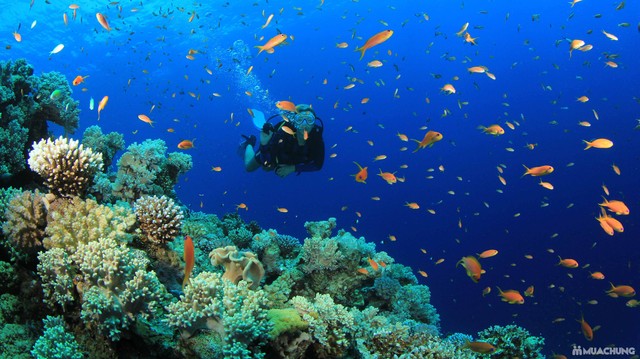
Nha Trang Bay Coral Reef – Source: https://dukhach.khanhhoa.gov.vn/
The Nha Trang Bay Marine Protected Area (MPA) (Khanh Hoa Province) includes islands such as Hon Tre, Hon Mieu, Hon Tam, Hon Mot, Hon Mun, Hon Cau, Hon Vung… and surrounding waters. The area is about 160 km², of which about 38 km² is land and 122 km² is water around the islands.
Nha Trang Bay is one of the most important areas for marine conservation and marine tourism in Vietnam. The coral reef is of international importance and has the highest biodiversity in Vietnam, including more than 222 species of reef fish, over 350 species of coral (accounting for 40% of the world’s reef-building corals), 120 species of mollusks, 70 species of crustaceans, 30 species of echinoderms, 70 species of seaweed and about 7 species of seagrass…, with diverse and rich marine ecosystems.
Coral Reef
Coral reefs play an important role in the formation and protection of the bottom structure, maintaining natural currents. Coral reefs are a shelter, breeding ground and development place for many marine species. According to research and statistics, Nha Trang Bay is a place where corals live and develop well, with an area of about 252 hectares with very high coverage and concentrated in the areas of Hon Mun (22 hectares), Hon Tam (20 hectares), Hon Rom (3.2 hectares), Hon Vung (4.6 hectares), Hon Cau (3.2 hectares) … Currently, only Hon Mun and Hon Rom are places with relatively stable coral reefs, while Vinpearl – Hon Tre, Bich Dam, Hon Mot are devastated by fishing activities and environmental impacts. Currently, the Institute of Oceanography has researched and successfully restored and regenerated corals in the wild. In recent times, Nha Trang Bay Management Board has made efforts to protect the integrity of the coral reefs in Hon Mun Strictly Protected Area and maintain the corals in good condition.
Mangrove ecosystem
The area of mangrove forests in Khanh Hoa province is about 104.08 hectares, of which Nha Trang Bay has about 7 hectares. This shows the decline of mangrove forests and the loss of habitat for aquatic species. In recent years, mangrove forests have been restored.
Seagrass beds
The total area of seagrass beds in Nha Trang Bay is about 78 hectares. Mainly distributed in Dam Tre, Hon Chong, Nam Tri Nguyen. Seagrass beds play an important role in the absorption of nutrients and metals in the marine environment to improve environmental pollution. At the same time, this is the habitat of many marine species. In recent years, seagrass beds have been seriously degraded due to environmental pollution, especially the amount of sediment that has been buried in large quantities in areas with seagrass beds. Although seagrass beds do not bring high economic value, they play a role in stabilizing, balancing biodiversity and maintaining aquatic resources.
In general, the ecosystems have contributed to creating biodiversity values and abundant aquatic resources in Nha Trang Bay, bringing economic value and prospects for sustainable tourism development.
Source: Department of Natural Resources and Environment



